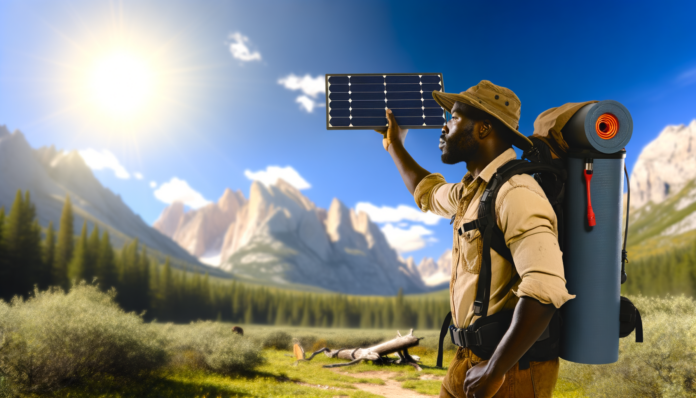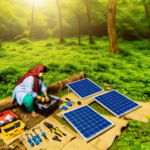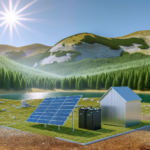Introduction to Solar Technology for Adventurers
The Growing Need for Sustainable Energy
In today’s world, the demand for sustainable energy solutions has never been more critical. As global populations rise and natural resources dwindle, the need for renewable energy sources becomes increasingly urgent. Traditional energy sources, such as fossil fuels, contribute significantly to environmental degradation and climate change. In contrast, renewable energy sources like solar power offer a cleaner, more sustainable alternative. Solar energy, in particular, has gained traction due to its abundance and potential to reduce carbon footprints. With advancements in technology and decreasing costs, solar power is becoming more accessible and practical for a wide range of applications, including those for outdoor enthusiasts and adventurers.
Why Solar Power is Ideal for Outdoor Enthusiasts
For outdoor enthusiasts, the appeal of solar power is multifaceted. Firstly, solar energy is a renewable resource, meaning it can be harnessed indefinitely without depleting natural reserves. This aligns perfectly with the ethos of sustainability that many adventurers hold dear. Secondly, solar power provides a reliable and portable energy source, essential for activities in remote locations where traditional power grids are unavailable. Whether you’re hiking, camping, or embarking on a long-term expedition, solar technology can keep your devices charged, provide lighting, and even power cooking equipment. The convenience and reliability of solar power make it an ideal companion for those who love to explore the great outdoors.
Overview of Recent Advances in Solar Technology
The solar industry has seen remarkable advancements in recent years, making solar technology more efficient, durable, and user-friendly. One of the most significant changes has been in the financing of solar projects, making installations more cost-effective and accessible. This shift has been driven by innovative financing methods that reduce investment demands, allowing more people to adopt solar solutions.
Technological advancements have also played a crucial role. The development of high-efficiency photovoltaic (PV) cells has significantly improved the performance of solar panels. Modern panels now boast efficiencies of up to 25%, a substantial increase from earlier models. Additionally, the introduction of flexible and lightweight solar panels has expanded the range of applications, making it easier to integrate solar technology into various outdoor gear.
Moreover, the industry has seen improvements in the durability and resilience of solar panels, ensuring they can withstand extreme weather conditions. This is particularly beneficial for adventurers who often find themselves in harsh environments. Innovations such as building-integrated photovoltaics (BIPV) and thin-film solar cells have also enhanced the aesthetic appeal and versatility of solar panels, making them more attractive and practical for everyday use.
In summary, the growing need for sustainable energy, coupled with the unique advantages of solar power for outdoor enthusiasts, underscores the importance of recent technological advancements. These innovations not only make solar power more accessible and efficient but also align with the values of sustainability and environmental stewardship that many adventurers cherish. As we continue to harness the power of the sun, the future looks bright for both the planet and those who explore it.
Portable Solar Panels: Power on the Go
Types of Portable Solar Panels
Portable solar panels come in various types, each designed to meet specific needs and preferences. The most common types include:
- Monocrystalline Panels: Known for their high efficiency and sleek design, these panels are made from a single crystal structure. They are ideal for users who need maximum power output in a compact form.
- Polycrystalline Panels: These panels are made from multiple silicon crystals and are generally less expensive than monocrystalline panels. They offer a good balance between efficiency and cost.
- Thin-Film Panels: Lightweight and flexible, thin-film panels are perfect for those who prioritize portability. They are less efficient than crystalline panels but can be more versatile in their applications.
- Foldable Solar Panels: These panels can be folded into a compact size, making them easy to transport and store. They are ideal for backpackers and campers who need a portable power solution.
Efficiency and Durability in Extreme Conditions
When it comes to outdoor adventures, efficiency and durability are crucial factors. Modern portable solar panels are designed to withstand extreme conditions, from scorching deserts to freezing mountains. Key features include:
- High Efficiency: Advances in photovoltaic technology have led to panels that can convert more sunlight into electricity, even in low-light conditions. Look for panels with Maximum Power Point Tracking (MPPT) technology to maximize efficiency.
- Durability: Many portable solar panels are built with rugged materials and reinforced frames to endure harsh environments. Waterproof coatings and impact-resistant designs ensure they can handle the rigors of outdoor use.
- Temperature Tolerance: Quality panels are designed to operate efficiently across a wide range of temperatures, ensuring reliable performance whether you’re in the heat of the desert or the chill of the mountains.
Setting Up and Using Portable Solar Panels
Setting up portable solar panels is straightforward, but a few tips can help you get the most out of your setup:
- Choose the Right Location: Place your panels in an area with maximum sunlight exposure. Avoid shaded spots and position the panels to face the sun directly.
- Adjust the Angle: Throughout the day, adjust the angle of the panels to follow the sun’s movement. This ensures consistent exposure and optimal power generation.
- Connect to Devices: Use the appropriate cables and connectors to link your panels to your devices or a portable power station. Many panels come with USB ports and other outlets for easy connectivity.
- Monitor Performance: Keep an eye on the power output and adjust the setup as needed. Some panels come with built-in indicators to help you track performance.
Maintenance and Care Tips
Proper maintenance can extend the lifespan of your portable solar panels and ensure they operate at peak efficiency:
- Regular Cleaning: Dust, dirt, and debris can reduce the efficiency of your panels. Clean them regularly with a soft cloth and mild detergent to keep the surface clear.
- Inspect for Damage: Check your panels for any signs of wear or damage, such as cracks or loose connections. Address any issues promptly to prevent further damage.
- Store Properly: When not in use, store your panels in a cool, dry place. Foldable panels should be stored in their protective cases to prevent scratches and other damage.
- Handle with Care: While portable solar panels are designed to be durable, they should still be handled with care. Avoid dropping or bending them to maintain their integrity.
By understanding the different types of portable solar panels and how to use and maintain them, modern adventurers can harness the power of the sun to stay connected and energized, no matter where their journeys take them.
Solar-Powered Gadgets for the Modern Adventurer
Solar Chargers for Devices
In the age of digital connectivity, staying powered up is crucial for modern adventurers. **Solar chargers** offer a sustainable solution to keep your devices running, whether you’re deep in the wilderness or on a remote mountain trail. These chargers are lightweight, portable, and designed to harness the sun’s energy efficiently. They can recharge smartphones, GPS units, cameras, and other essential gadgets, ensuring you remain connected and safe throughout your journey. Many models come with multiple USB ports, allowing you to charge several devices simultaneously, and some even feature built-in batteries to store energy for use during cloudy days or nighttime.
Solar-Powered Lighting Solutions
Proper lighting is essential for any outdoor adventure, and **solar-powered lighting solutions** provide an eco-friendly way to illuminate your campsite. From lanterns and torches to string lights, these devices use solar panels to capture and store energy during the day, offering extended run times and various brightness settings. Modern solar lanterns are often equipped with features like USB charging ports and built-in power banks, making them versatile tools for any adventurer. **Headlamps** with solar charging capabilities are also popular, providing hands-free lighting for nighttime trekking or campsite activities.
Solar Cooking and Heating Devices
Cooking and heating in the great outdoors have been revolutionized by **solar-powered devices**. **Solar cookers** use reflective materials to concentrate sunlight, allowing you to cook meals without the need for traditional fuels. These cookers are perfect for preparing hot meals, boiling water, and even baking, all while reducing your carbon footprint. **Solar-powered heaters** can also provide warmth during chilly nights, making your camping experience more comfortable. These devices are not only environmentally friendly but also eliminate the need to carry heavy fuel canisters, lightening your load.
Innovative Solar Gadgets for Outdoor Activities
The market for **solar-powered gadgets** is continually expanding, offering innovative solutions for various outdoor activities. **Solar-powered water purifiers** use ultraviolet (UV) light to kill bacteria and viruses, ensuring you have access to safe drinking water. **Solar backpacks** come with built-in panels to charge your devices on the go, making them ideal for hikers and cyclists. **Solar-powered tents** with integrated lighting and charging stations are also gaining popularity, providing a self-sufficient shelter for extended trips. These innovations not only enhance your outdoor experience but also promote sustainable practices by reducing reliance on non-renewable energy sources.
Incorporating solar-powered gadgets into your outdoor gear not only enhances your adventure but also supports a more sustainable and eco-friendly way of exploring nature. Whether you’re charging your devices, lighting up your campsite, cooking meals, or purifying water, solar technology offers reliable and efficient solutions for the modern adventurer.
Solar Energy Storage Solutions
Portable Solar Batteries and Power Banks
Portable solar batteries and power banks have revolutionized the way adventurers harness and store solar energy. These devices allow outdoor enthusiasts to capture solar energy during the day and store it for use when the sun isn’t shining. **Portable solar batteries** come in various sizes and capacities, making them suitable for different needs, from charging small devices like smartphones and cameras to powering larger equipment like laptops and portable refrigerators.
**Key features** of portable solar batteries include:
– **High capacity**: Capable of storing significant amounts of energy.
– **Lightweight and compact**: Easy to carry and pack.
– **Durability**: Built to withstand harsh outdoor conditions.
– **Multiple output ports**: Allowing simultaneous charging of multiple devices.
**Power banks** are smaller, more portable options that are perfect for short trips or day hikes. They typically have lower capacities but are incredibly convenient for keeping essential devices charged.
Integrating Solar Storage with Existing Gear
Integrating solar storage solutions with existing outdoor gear can enhance the efficiency and convenience of energy use in the wild. Many modern backpacks, tents, and even clothing items now come equipped with built-in solar panels and storage options.
**Tips for integration**:
– **Choose compatible gear**: Ensure that your solar panels, batteries, and devices are compatible in terms of voltage and connectors.
– **Modular systems**: Opt for modular systems that allow you to add or remove components based on your needs.
– **Smart management**: Use smart controllers to manage the flow of energy between your solar panels, batteries, and devices, optimizing efficiency and preventing overcharging.
For example, a solar-powered backpack can charge a power bank during the day, which can then be used to charge your devices at night. Similarly, solar tents with integrated panels can provide a steady power supply for lighting and small appliances.
Maximizing Efficiency and Lifespan of Solar Batteries
To get the most out of your solar batteries, it’s essential to maximize their efficiency and lifespan. Here are some **best practices**:
1. **Proper Charging**: Avoid overcharging or completely draining your batteries. Use charge controllers to regulate the charging process.
2. **Temperature Management**: Keep batteries within their optimal temperature range. Extreme temperatures can reduce efficiency and lifespan.
3. **Regular Maintenance**: Clean the solar panels regularly to ensure maximum sunlight absorption. Check connections and cables for wear and tear.
4. **Storage**: When not in use, store batteries in a cool, dry place. Partially charge them before long-term storage to maintain their health.
5. **Quality Matters**: Invest in high-quality batteries and power banks from reputable manufacturers. They may cost more upfront but will save money in the long run through better performance and durability.
By following these guidelines, adventurers can ensure that their solar energy storage solutions remain reliable and efficient, providing a sustainable power source for all their outdoor activities.
Case Studies: Solar Technology in Action
Real-Life Applications by Outdoor Enthusiasts
Outdoor enthusiasts have increasingly turned to solar technology to power their adventures, finding it a reliable and sustainable energy source. For instance, long-distance hikers on trails like the Pacific Crest Trail and the Appalachian Trail often carry portable solar panels to charge their GPS devices, smartphones, and headlamps. These solar panels are lightweight, foldable, and can be easily attached to backpacks, allowing hikers to harness the sun’s energy while on the move.
Another popular application is in the realm of water sports. Kayakers and sailors use solar-powered desalination units to convert seawater into drinkable water, ensuring they stay hydrated without carrying large quantities of fresh water. Additionally, solar-powered navigation lights and communication devices are essential for safety during extended trips on the water.
Off-Grid Living: Success Stories
Off-grid living has become a viable lifestyle choice for many, thanks to advancements in solar technology. One notable success story is that of the “Earthship” communities in New Mexico. These sustainable homes are built with recycled materials and are entirely off-grid, relying on solar panels for electricity. The residents use solar energy to power everything from lighting and heating to water pumps and household appliances.
In another example, a family in the remote Alaskan wilderness has successfully lived off-grid for over a decade. They use a combination of solar panels and wind turbines to generate electricity, storing excess energy in batteries for use during the long, dark winters. This setup has allowed them to maintain a modern lifestyle, complete with internet access and electric heating, without relying on fossil fuels.
Emergency Preparedness and Solar Solutions
Solar technology has proven invaluable in emergency preparedness and disaster response scenarios. After natural disasters like hurricanes and earthquakes, traditional power grids can be down for days or even weeks. Solar-powered generators and portable solar panels provide a critical lifeline, enabling affected communities to charge essential devices, power medical equipment, and maintain communication with the outside world.
For example, during the aftermath of Hurricane Maria in Puerto Rico, solar-powered water purification systems were deployed to provide clean drinking water to communities cut off from municipal supplies. Similarly, solar-powered lanterns and phone chargers were distributed to help residents stay connected and navigate their surroundings safely.
In another instance, a non-profit organization used solar technology to set up temporary clinics in remote areas of Nepal following the 2015 earthquake. These clinics were equipped with solar panels to power medical devices, refrigeration for vaccines, and lighting, ensuring that medical care could be provided around the clock.
By examining these real-life applications, off-grid living success stories, and emergency preparedness scenarios, it becomes clear that solar technology is not just a theoretical solution but a practical and essential tool for modern adventurers and those seeking sustainable living options.
Environmental and Economic Benefits of Solar Technology
Reducing Carbon Footprint
Solar technology offers a significant advantage in reducing the carbon footprint of outdoor activities. Unlike traditional energy sources that rely on fossil fuels, solar power generates electricity without emitting greenhouse gases or pollutants. This clean energy source harnesses the sun’s abundant and renewable energy, making it an environmentally friendly option for adventurers. By utilizing solar-powered devices and systems, outdoor enthusiasts can minimize their impact on the environment, contributing to the fight against climate change and the preservation of natural landscapes.
Long-Term Cost Savings
One of the most compelling economic benefits of solar technology is the potential for long-term cost savings. While the initial investment in solar panels and related equipment can be substantial, the ongoing savings on energy costs can be significant. Solar power allows adventurers to generate their own electricity, reducing or even eliminating the need to purchase power from traditional sources. Over time, this can lead to substantial savings, especially in remote or off-grid locations where energy costs can be high. Additionally, solar technology provides a hedge against rising energy prices, offering financial stability and predictability for outdoor enthusiasts.
Supporting Sustainable Practices
Embracing solar technology aligns with broader sustainable practices that are increasingly important in today’s world. By choosing solar-powered solutions, adventurers support the development and adoption of renewable energy technologies. This not only helps reduce reliance on non-renewable energy sources but also promotes the growth of the solar industry, which in turn drives innovation and job creation. Furthermore, the use of solar power in outdoor activities encourages a culture of sustainability and environmental stewardship, inspiring others to consider the ecological impact of their energy choices.
In conclusion, the environmental and economic benefits of solar technology make it an ideal choice for modern adventurers. By reducing carbon footprints, offering long-term cost savings, and supporting sustainable practices, solar power provides a clean, efficient, and responsible energy solution for those who love the great outdoors.
Future Trends in Solar Technology for Adventurers
Emerging Innovations and Research
The solar technology landscape is rapidly evolving, with numerous innovations poised to revolutionize how adventurers harness solar energy. One of the most promising developments is the advent of **perovskite solar cells**. These cells are made from perovskite-structured compounds, which are cheaper and easier to produce than traditional silicon cells. They have the potential to reach higher efficiencies, with some experimental cells already surpassing the efficiency of the best silicon cells. This could make solar energy more accessible and affordable for outdoor enthusiasts.
Another exciting innovation is the development of **bifacial solar panels**. Unlike traditional panels that only capture sunlight from one side, bifacial panels can absorb light from both the front and back. This dual absorption capability significantly increases their power output, making them ideal for environments where sunlight can be reflected off surfaces like snow, water, or light-colored ground.
**Flexible and lightweight solar panels** are also gaining traction. These panels can be easily integrated into various outdoor gear, such as backpacks, tents, and clothing, providing a seamless way to generate power on the go. This flexibility ensures that adventurers can maintain a steady power supply without carrying bulky equipment.
Potential Impact on Outdoor Activities
The advancements in solar technology are set to have a profound impact on outdoor activities. For instance, the increased efficiency and portability of solar panels mean that adventurers can now embark on longer trips without worrying about running out of power. This is particularly beneficial for activities like **backpacking, mountaineering, and long-distance cycling**, where access to traditional power sources is limited.
Moreover, the integration of solar technology into outdoor gear can enhance safety and convenience. **Solar-powered GPS devices, communication tools, and emergency lighting** can be lifesavers in remote areas. Additionally, solar-powered cooking and heating devices can make camping more comfortable and sustainable, reducing the need for disposable fuel sources.
The environmental benefits are also significant. By relying on solar power, adventurers can minimize their carbon footprint, contributing to the preservation of the natural landscapes they cherish. This aligns with the growing trend of **eco-friendly travel and sustainable outdoor practices**.
How to Stay Updated on Solar Technology
Staying informed about the latest developments in solar technology is crucial for modern adventurers who want to leverage these innovations. Here are some ways to keep up-to-date:
- Follow Industry News: Websites and publications dedicated to renewable energy and outdoor gear often feature the latest advancements in solar technology. Subscribing to newsletters from reputable sources can provide regular updates.
- Join Online Communities: Forums and social media groups focused on outdoor activities and renewable energy are excellent platforms for sharing information and experiences. Engaging with these communities can provide insights into practical applications of new technologies.
- Attend Trade Shows and Conferences: Events like the Outdoor Retailer Show and renewable energy expos showcase the latest products and innovations. Attending these events can offer hands-on experience with new gear and direct interaction with industry experts.
- Subscribe to Research Journals: Academic journals and research publications often feature cutting-edge studies on solar technology. Subscribing to these can provide in-depth knowledge of emerging trends and scientific breakthroughs.
By staying informed and embracing new technologies, adventurers can enhance their outdoor experiences while contributing to a more sustainable future. The future of solar technology holds immense promise, and those who stay ahead of the curve will be well-equipped to harness the sun’s power in innovative and exciting ways.






